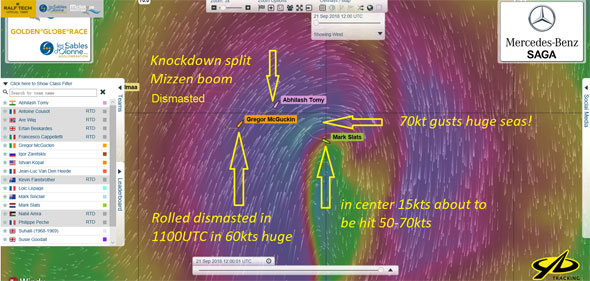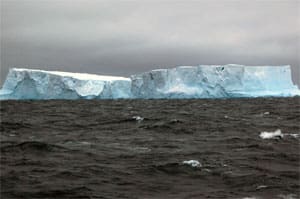The Southern Ocean has always been challenging for sailors. New evidence suggests climate change has made passages through the world’s southernmost ocean even more taxing.
Temperatures in the Southern Ocean have risen substantially since the 1930s, creating conditions for stronger winds and storm activity. A recent study conducted by researchers at the University of California Santa Cruz suggests waves are getting taller and more powerful around the world, with the biggest increases in the Southern Ocean.
“Climate change is characterized by some key ‘markers’ or ‘fingerprints’,” said Borja Reguero, a researcher at the Institute of Marine Sciences at UC Santa Cruz, referring to rising temperatures or concentrations of CO2. “Our research found a similar global warming signal in the power of waves.”
“We detected increases in wave power, which is the transfer of wind energy into ocean waves, of 0.4 percent per year globally, but larger increases in the Southern Ocean at 0.58 percent a year,” Reguero continued.
The UC Santa Cruz study draws some important conclusions about possible consequences of bigger and more powerful waves. Coastal communities susceptible to storm surges could be affected. There could also be implications for harbors historically spared from ocean waves.
 |
|
A graphic showing how a single storm damaged multiple Golden Globe race boats. |
|
Courtesy Golden Globe Race |
Perhaps most significant for mariners is the potential for rougher sea states and taller, more powerful waves during major storm events. “We can state that we will see more energetic conditions on average. Specific changes for the most extreme events, the ones with the most extreme wave heights, will be higher,” Reguero said.
Another recent study by Ian Young and Agustinus Ribal reached similar conclusions as researchers at UC Santa Cruz. The study, published in the journal Science last year, used satellite data to track changes in wind speeds and wave height between 1985 and 2018. They found “small increases” for both. Again, the Southern Ocean had the biggest increases.
Single-handed racers
The timing of this research coincides with two single-handed around-the-world sailing races that brought more than three dozen sailors through the Southern Ocean. There were 26 entrants in the Longue Route, while 18 participated in the Golden Globe Race. For racers in the latter contest, which started and ends at Les Sables-d’Olonne in France, the Southern Ocean more than lived up to its reputation.
Golden Globe winner Jean-Luc Van Den Heede’s Holman & Pye Rustler 36, Matmut, pitchpoled during a hellish storm some 2,000 miles west of Cape Horn, damaging his mast and slowing his progress for some time afterward. Mark Slats, a Dutch skipper who finished second, was knocked down hard — twice — roughly 1,750 miles southwest of Perth, Australia, during a storm that brought 70-knot winds and over 30-foot seas. Vessels skippered by Abhilash Tomy and Gregor McGuckin also were dismasted in the storm, and both were forced to retire.
Tomy, of India, suffered a severe back injury when his yacht, Thuriya, dismasted. A French fisheries research vessel rescued him days later. McGuckin, of Ireland, also dismasted and was rescued by an Australian frigate. McGuckin described the conditions to race organizers in a satellite phone call.
 |
|
Crew from the French Fisheries Patrol ship Osiris board Abhilash Tomy’s dismasted yacht, Thuriya, to rescue the injured yachtsman. |
|
Courtesy Golden Globe Race/Indian Navy |
“Massive sea and wind from the SW. Now struggling to keep the boat facing downwind. We took a really bad knock when we lost the mizzenmast. It went off like a bomb and also hit the wind vane and the main backstay. I wanted to keep [the mizzen] but was forced to cut it free,” he said, according to a release from race organizers.
“Now sailing under bare poles and towing warps, and still making over 6 knots,” McGuckin continued. “Getting knocked hard by waves. This sustained force 9 is incredible. The barometer dropped off the scale from 1015 in just a few hours.”
Possible gear failure
British sailor Susie Goodall was injured when her yacht, DHL Starlight, pitchpoled and dismasted roughly 2,000 miles west of Cape Horn. She was using a Jordan series drogue at the time, and has suggested a line parted just before the incident, potentially contributing to pitchpoling.
The impact knocked her out briefly, but she was able to communicate with race organizers, telling them a jury-rig was not possible. Goodall was later rescued by a cargo ship that diverted and hoisted her on board with its crane.
Goodall told race officials that the wind stopped howling through her rigging just before the wave hit her vessel. “This might indicate that the wave was large enough to shelter the boat, in which case it must have been huge and steep. Her thought was that the violence of the wave to cause a pitchpoling indicates it was no ordinary wave,” according to a report by Sir Robin Knox-Johnston regarding the five dismastings that affected the Golden Globe fleet in the Southern Ocean.
 |
|
British sailor Susie Goodall is hoisted aboard a Chinese merchant ship after her boat was dismasted. |
|
Courtesy Golden Globe Race |
Knox-Johnston, who won the original Sunday Times Golden Globe Race held 50 years ago, highlighted the potentially damaging effects of large waves. In the report, he said so-called “rogue waves” can reach 80 feet or larger, and are exponentially more powerful than a 12-meter breaking wave. The study notes that faster ocean racing vessels can typically outrun rogue waves while the smaller, heavier yachts used in the Golden Globe race cannot.
The report breaks down the individual circumstances of the knockdowns, including if the yachts had sails raised and whether they used drogues or warps. The short answer is this: Knockdowns occurred in just about every circumstance. Only Tapio Lehtinen, the last competitor still on the course, reported no knockdowns.
American Istvan Kopar, who finished fourth aboard the Tradewind 35 Puffin, did not use drogues, according to Knox-Johnston’s report. Kopar, who returned to Florida in mid-May, “kept sail on in storms but still suffered knockdowns and felt his boat was safest when the wind was from the beam to the quarter,” Knox-Johnston wrote.
The sailing world closely followed the Golden Globe Race, particularly the “carnage” that occurred in the Southern Ocean. But longtime sailors point out that sailing in that part of the world has always been treacherous — which, for some, is part of the appeal.
“When you have an event like the Golden Globe where you have a bunch of amateurs, with a few exceptions, you have a higher likelihood of them getting into trouble,” said Charles Doane, marine writer and author of the blog WaveTrain.
 |
|
French sailor Loïc Lepage’s boat, Laaland, after he was rescued by the Japanese bulk carrier Shiosai 670 miles southwest of Perth, Western Australia. |
|
Courtesy Golden Globe Race |
Outrunning big waves
He adds that professional racers in larger, high-end vessels in some cases outrun the bad weather and waves. “They can ride the low-pressure systems like surfers ride the waves,” he said. “At that level, waves getting bigger isn’t necessarily a bad thing, they just need to be professional and aware of what they are doing.”
Randall Reeves is looking to become the first sailor to complete a solo “figure 8” route around the Americas and Antarctica, starting in San Francisco, then circling Antarctica and running through the Northwest Passage. He agrees experience matters in the Southern Ocean, no matter what climate change is doing to the weather or sea state.
“What I learned during round one (my first experience) helped me succeed in round two,” he said by email while sailing north in the Atlantic Ocean. “I knew going into round one that I wanted to sail through the worst weather (rather than use a storm drogue), but I wasn’t careful enough to keep boat speed up. Boat speed equals safety.
“The wave is always traveling faster than the boat, and the faster the boat goes, the slower the wave approaches … speed robs it of some of its power. Also, speed gives the boat quicker response time as more water is flowing more quickly by the rudder,” Reeves continued.
Based on the recent research, however, it appears likely that climate change will make an already harrowing passage that much harder. Whether that has any effect on sailors’ desire to sail through the Southern Ocean remains to be seen.
Casey Conley is a staff writer for Professional Mariner and Ocean Navigator magazines, and editor of American Tugboat Review.

